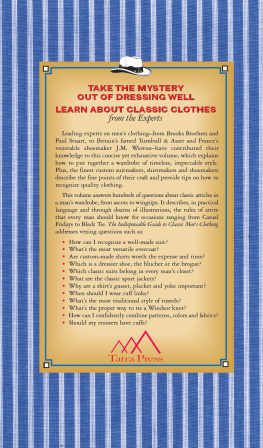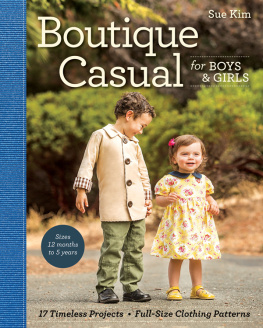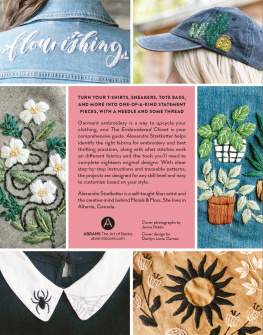T HE I NDISPENSABLE G UIDE
TO
C LASSIC
M ENS
C LOTHING
BY J OSH K ARLEN AND C HRISTOPHER S ULAVIK
I LLUSTRATED BY A MY L IBRA
T ATRA P RESS
N EW YORK
1999 Josh Karlen and Christopher C. Sulavik
All rights reserved. No segment of this book may be reproduced or transmitted electronically in any form or through any means, including recording, photocopying, or by any information storage or retrieval system, without the written permission of the publisher.
Note: This book should be used as a general reference guide. The authors and publisher will not be liable or responsible for any person or entity in relation to any loss or damage caused, or purported to be caused, indirectly or directly, by the information listed in this book.
Library of Congress Catalog Card Number: 99-60699
ISBN: 0-9661847-1-8
Writers: Josh Karlen and Christopher C. Sulavik
Cover designed by: Regina Ranonis
Illustrator: Amy Libra
Printer: Quebecor Printing
Publisher: | Tatra Press
111 Congress Street
Brooklyn, New York 11201 |
Printed in the United States of America
For Lorraine and Emily
Acknowledgment
The authors extend their sincere thanks to the many people who so generously offered their time and expertise during the research for this book. A special thanks to Stephane Houy-Towner of The Costume Institute at The Metropolitan Museum of Art.
J.K., C.S.
P REFACE
Classics never go out of style.
Stephen Milstein, vice president, Burlington Coat Factory
Fashion is fleeting, style is permanent.
Daniel Patrick Heaney, general manager, Sulka
F or many men, getting dressed each morning is not the simple task it should be. They hesitate before closets overflowing with clothes, and puzzle over questions such as: Can I wear my herringbone jacket with my striped shirt? Is it appropriate to wear my button-down collar with my double-breasted suit? Is my casual outfit too casual for my office? Such questions can linger for years, even decades. And a visit to the haberdasher often devolves into a compassless journey through a wilderness of jackets, shirts and coats, prompting still more questions: Are these shoes the paragons of craftsmanship that the salesperson insists they are? Will this tie go with all the outfits Id like to wear it with? Is this suit worth the small fortune demanded for it?
On these points, men often defer to the advice of salespeoplemost of whom are competent, helpful guides. But some are ill-informed, rushed and driven by commissions. As a result, men too often end up settling for suits that fall out of fashion or that fit poorly, shoes that pinch, ties that dont agree with their taste or the rest of their wardrobe. And so, they end up back before their closets, examining their clothes with trepidation.
Why are so many men unfamiliar with the basic principles of dressing well and unable to discern quality clothing? Perhaps because many fathers dont educate their sons about things sartorial, because of their own uncertainty about clothing or a belief that the subject is trivial. However, the clothes we wear are far from trivial. Our choice of suit, coat, shoes, and so forth, powerfully influences how colleagues and acquaintances perceive us. We are judged to be successful or struggling, a conformist or a rebel, a details man or careless, based largely on our appearance. Impressions based on our clothing may be superficial, but they are inevitable. As Lord Chesterfield famously observed more than two centuries ago: Dress is a very foolish thing, and yet it is a very foolish thing for a man not to be well dressed.
So, what does the well-dressed man wear? Men of style have always chosen classic clothing, which, like the classics we studied in school, are creations of the highest quality of craftsmanship and of aesthetic beauty. Their indefatigable elegance imparts confidence and endures changes of fashion, which, in addition, makes them a wise investment.
This book seeks to provide readers with an education in these classic mens clothes: how to recognize them among crowded shop racks, and how to wear them well. Whether you are starting a career and building your first serious wardrobe, seeking to add panache to your attire, or wishing to become an educated consumer, we believe you will find the guidelines in this book useful. If you are among those men who puzzle before their closets each morning, we hope this book will make getting dressed simple, and even enjoyable.
During the research for this book, we spoke with dozens of experts at the most venerable clothiers in the United States and abroad. We also interviewed purveyors of the finest fabrics, and spoke with the most sought-after image consultants. These experts occasionally offered divergent opinions; however, to set them down in every instance would serve no purpose. Instead, we chose to note only those contrary views that are held by a significant minority of the knowledgeable people we spoke with. Suffice it to say that for almost every opinion there is a contrasting one, and for every generality we make, there are many exceptions.
J.K., C.S.

S UITS
The suit is no longer a suit. Its a statement.
Garrick Anderson, designer, Garrick Anderson Sartorial Ltd.
T he suit is unquestionably the most important article of clothing in a mans wardrobe. It is the uniform of businessmen from Tokyo to Moscow to New York, and will likely remain so for years to come.
The essential elements of the mans suit have changed remarkably little during the 20th century, and the contemporary suitwhether an updated Sack, a Savile Row or an Italian cutremains an easily recognizable descendant of 19th century frock coats and lounge suits. However, there have been countless variations on the classic suits over the years, providing men with myriad choices of silhouettes, colors and fabrics. These variationssome stark, some subtlecan send very different messages about the wearers style, his personality, what he does for a living and how successful he is. So it is prudent to consider carefully before making a substantial investment in a suit. Generally, you want to acquire suits that not only possess craftsmanship that will last many years, but that are also cut in one of the variations of the classic styles, so that they will endure passing fashions.
This chapter describes classic suit silhouettes, materials and fabric patterns. It also shows you how to recognize quality, so you can select a suit based on sound knowledge, not on the price tag or the brand label.

What are the classic suit styles?
Each suit style is distinguished by its silhouette (the character of a suits lines). Three silhouettes have lasted for many decades: the American Sack, the British and the Italian. However, these categories are not rigid, and you will see variations when you browse through suit racks; even classics get tweaked and updated. In the 1950s, it was perhaps easier to tell the difference between the American, British and Italian styles, says Garrick Anderson, designer for Garrick Anderson Sartorial Ltd. Today, we still hold an idea of the distinctions of these styles. However, these distinctions have become blurred. For example, you might see an Italian designer producing a very British-looking suit, or an American company designing suits with what was once considered a strictly Italian look, says Mr. Anderson.






